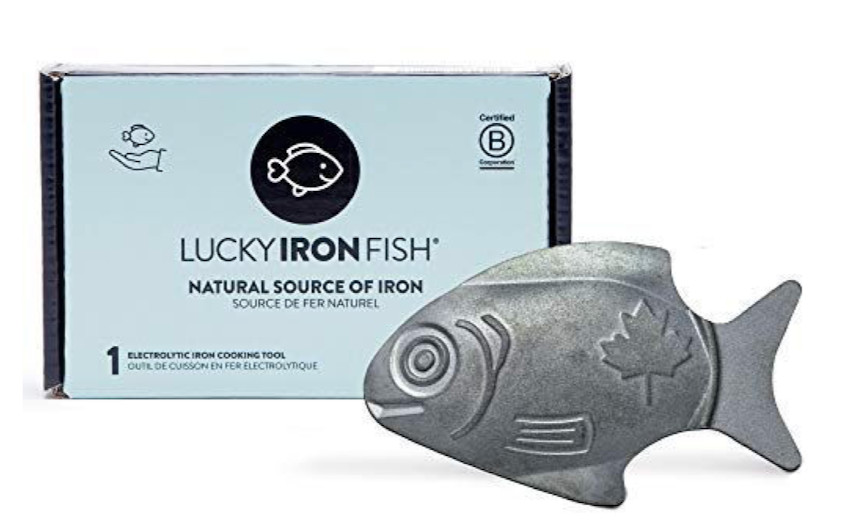Running News Daily
Running News Daily is edited by Bob Anderson. Send your news items to bob@mybestruns.com Advertising opportunities available. Train the Kenyan Way at KATA Kenya and Portugal owned and operated by Bob Anderson. Be sure to catch our movie A Long Run the movie KATA Running Camps and KATA Potato Farms - 31 now open in Kenya! https://kata.ke/
Index to Daily Posts · Sign Up For Updates · Run The World Feed
Endurance Athletes Have an Increased Risk for Iron Deficiency
Poor performances and feelings of fatigue may signal a need to get your levels checked.
It’s common to associate a poor performance with low iron. “I had a bad race, maybe I should check my iron?” “I’m feeling fatigued during workouts—could it be my iron levels?” I get these questions from the athletes I work with a lot.

And while there are countless variables that can contribute to poor performances or fatigue, one thing we do know is that iron is important for runners. If your iron levels are low and you don’t do anything about it, you will eventually feel the negative impact on performance. Here’s what you need to know about both iron and ferritin levels.
What is iron and why is it important for athletes?
Iron is an essential mineral found in red blood cells that is important for oxygen transport in the blood and to muscles, energy production, cognition, and immunity. The reason many of us worry about our levels is that iron is lost in many ways: in the urine, through the menstrual cycle, blood loss in the gastrointestinal (GI) tract, sweat loss, and the breakdown of red blood cells via the impact of our foot strikes. Plus, chronic use of nonsteroidal anti-inflammatory drugs (e.g. ibuprofen, naproxen)—ones often used by athletes—and antacids can also lead to iron deficiency. 
​
Iron levels are especially important for female athletes: According to a paper in the European Journal of Applied Physiology, the prevalence of iron deficiency is around 15 to 35 percent in female athletes and 3 to 11 percent in males. Females, endurance runners, vegans, vegetarians, and athletes with low energy availability are at an increased risk for iron deficiency.

What are some key symptoms of low iron?

The classic signs of iron deficiency, with or without anemia, include lethargy, fatigue, negative mood state, and difficulty concentrating. However, runners may notice symptoms that mimic overtraining, reduced work capacity during training, impaired responses to training, and ultimately poor performance. The only way to determine if low iron is the culprit is to have a blood test.
What about anemia?
Anemia is a condition in which the blood doesn’t have enough healthy red blood cells. Although iron deficiency anemia is the most common type of anemia, it is one of many different types. It is possible to have iron deficiency prior to developing a diagnosis of iron deficiency anemia. Over time, iron deficiency will lead to anemia if no action is taken because the body will exhaust its iron stores, known as ferritin.
So what’s the deal with ferritin levels?
Ferritin, as mentioned above, is an important blood marker that indicates iron storage. There is a wide range for what is considered to be a “normal ferritin level,” ranging from 12 to 300 nanograms per milliliter (ng/mL).
“However, linking ferritin levels (e.g. levels greater than 35ng/ml) directly to performance is very challenging, as there are so many things that impact performance,” Trent Stellingwerff, PhD, Senior Advisor for the Canadian Sport Institute Pacific tells Runner’s World.
In fact, high iron levels can be very toxic for the liver and heart. “We aim for ferritin greater than 35ng/ml and clinically normal hemoglobin, but appreciate individual athlete norms as well,” says Stellingwerff.
Thus, a current routine assessment of iron deficiency should include the following blood markers: ferritin, hemoglobin, and transferrin saturation. Iron deficiency occurs in three stages using the following ferritin levels proposed in a recent paper in athletes:
Stage1 - Iron deficiency/depletion: ferritin less than 35 ng/mL, hemoglobin and transferrin levels will still be normal. There is little evidence to suggest you will notice any fatigue at this point, but it’s important to correct and prevent iron deficiency anemia.
Stage 2 - Iron deficient non-anemia: ferritin less than 20ng/mL, low transferrin, and normal hemoglobin. You may start to feel some of the symptoms above and performance may be negatively impacted.
Stage 3 - Iron deficiency anemia: ferritin less than 12 ng/mL, low transferrin and hemoglobin. You will notice key symptoms above including impaired endurance performance.
How often should I have my iron levels checked?
As suggested in a recent 2019 article published in a European Journal of Applied Physiology, high-risk runners should be screened regularly and considerations for the frequency of iron blood screening are based on the athlete’s past history. Although not comprehensive, some guidelines are listed below:
Annually: runners with no history of iron deficiency, no fatigue after an extended rest period
Biannually: previous history or low ferritin (iron depletion stage 1), female, intention to increase training volume or training at altitude within the next 12 months
Quarterly: any recent history of iron depletion/deficiency, vegetarian/vegan, individuals with any evidence of low energy availability, high training volume, and fatigue/lethargy, plans to train at altitude within the next 6 months.
Ferritin, an acute phase reactant protein, can be falsely elevated with inflammation after intense exercise. Thus, it’s important to avoid any muscle-damaging or intense exercise about two to three days prior to your routine blood test. Other suggestions for standardization include testing first thing in the morning and in a well-hydrated state.
Work with your doctor to determine the best course of action and figure out if supplementation is right for you.
Should runners traveling to altitude be concerned about levels?
Training at low to moderate altitudes provides an environmental stimulus to increase red blood cells with the goal of improving performance at sea level. With this increase in red blood cell production, comes an additional need for iron. A review paper by Stellingwerff et al. (2019) suggests checking iron status prior to altitude training to ensure that levels are in the optimal range prior to leaving.
“However, if a runner is just going to altitude for a race or short period of time, the impact of iron is much less,” Stellingwerff says. “Although, all endurance athletes should aim to have ferritin levels well into the healthy and normal range.”
How can runners optimize iron absorption?
You can have a solid iron-rich fueling plan, but is your nutrient-timing and combination of foods on point? Iron absorption may be impaired post-exercise due to increased levels of hepcidin, a hormone released by the liver that regulates the ability to absorb or recycle iron (e.g. increased hepcidin levels will inhibit iron absorption).
Inflammation is believed to be a strong up regulator of hepcidin. According to an article published in Sports Medicine in 2020, hepcidin increases around three to six hours post-exercise and increases towards the end of the day.

Thus, the optimal timing for iron absorption is within 30 minutes after a morning workout when hepcidin levels are low. Runners can optimize iron absorption use the following strategies:
​
Avoid dairy, coffee, and tea (which decrease absorption of iron) for an hour before or after a meal.
Cook with a cast-iron skillet or a product like a Lucky Iron Fish, which may be a cost-effective strategy for increasing the iron in conjunction with other methods according to one study.
Consume “heme iron” rich foods such as beef, eggs, tuna, lamb, and kangaroo (if available)
Improve absorption of “non-heme iron” sources (almonds, figs, apricots, kidney beans, green leafy vegetables, tofu, dark chocolate) by pairing with heme-rich sources and/or ~50 milligrams (mg) of vitamin C (1/2 cup of pineapple, strawberries, broccoli, or red peppers).
If taking an iron supplement (prescribed by a physician), take with vitamin C-rich food. Emerging evidence suggests alternate day dosing to be just as effective as daily for raising ferritin levels and better tolerated for runners with a sensitive gut.

Finally, not every bad race indicates your iron is low, but it is a good idea to get checked prior to taking any iron supplements. There is no evidence that higher ferritin levels are better (e.g. aiming for 300), and supplementation is not likely to improve performance in non-depleted runners. Iron supplementation should only occur under physician supervision.
You can have a solid iron-rich fueling plan, but is your nutrient-timing and combination of foods on point? Iron absorption may be impaired post-exercise due to increased levels of hepcidin, a hormone released by the liver that regulates the ability to absorb or recycle iron (e.g. increased hepcidin levels will inhibit iron absorption).
Inflammation is believed to be a strong up regulator of hepcidin. According to an article published in Sports Medicine in 2020, hepcidin increases around three to six hours post-exercise and increases towards the end of the day.

Thus, the optimal timing for iron absorption is within 30 minutes after a morning workout when hepcidin levels are low. Runners can optimize iron absorption use the following strategies:
​
Avoid dairy, coffee, and tea (which decrease absorption of iron) for an hour before or after a meal.
Cook with a cast-iron skillet or a product like a Lucky Iron Fish, which may be a cost-effective strategy for increasing the iron in conjunction with other methods according to one study.
Consume “heme iron” rich foods such as beef, eggs, tuna, lamb, and kangaroo (if available)
Improve absorption of “non-heme iron” sources (almonds, figs, apricots, kidney beans, green leafy vegetables, tofu, dark chocolate) by pairing with heme-rich sources and/or ~50 milligrams (mg) of vitamin C (1/2 cup of pineapple, strawberries, broccoli, or red peppers).
If taking an iron supplement (prescribed by a physician), take with vitamin C-rich food. Emerging evidence suggests alternate day dosing to be just as effective as daily for raising ferritin levels and better tolerated for runners with a sensitive gut.

Finally, not every bad race indicates your iron is low, but it is a good idea to get checked prior to taking any iron supplements. There is no evidence that higher ferritin levels are better (e.g. aiming for 300), and supplementation is not likely to improve performance in non-depleted runners. Iron supplementation should only occur under physician supervision.
by Runner’s World
Login to leave a comment




